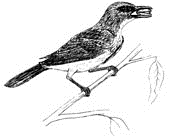Vertebrate Pest Conference: Proceedings

Vertebrate Pest Conference Proceedings: 17th (1996)
Date of this Version
1996
Document Type
Article
Citation
Published in Proceedings: Seventeenth Vertebrate Pest Conference … 1996, ed. Robert M. Timm & A. Charles Crabb (University of California, Davis, 1996).
Abstract
Diphacinone treated oat groats were effective in reducing populations of California ground squirrels (Spermophilus beecheyi) by more than 84%. Two concentrations of active ingredient (0.005% and 0.01%) were compared, as well as two application methods: spot baiting and bait stations. Squirrel activity on test plots was assessed before and after bait applications using visual counts and active burrow counts. There was good correspondence between results of the two activity indices. There was no significant improvement in efficacy provided by the higher concentration of diphacinone. Bait consumption was much lower on bait station plots. Squirrel carcasses were found on treated areas at a rate of approximately one carcass per acre. Tissue residue analysis determined that residue loads were nearly identical regardless of the concentration of bait consumed or method of baiting.
Included in
Animal Sciences Commons, Bioresource and Agricultural Engineering Commons, Environmental Engineering Commons


Comments
Copyright © 1996 (where applicable) by the Vertebrate Pest Council of the Vertebrate Pest Conference. Used by permission.